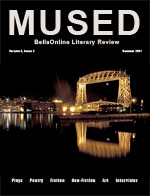Arabesque
Liane Kupferberg Carter
I was dragged to Ruth Skaller’s Ballet Studio for Girls the year I was seven. I had never expressed any interest in dancing. But earlier that year, I’d had surgery on my eyes, and someone suggested that dancing might help my coordination.
Ruth Skaller was a tall, olive-skinned woman of indeterminate age, whose classes were filled with giggling girls she whipped into line with the snap of her voice. Through a series of barre exercises, we would sweep our Capezio slippers over the polished pale wood floors, plié, rond de jambe, relèvé, to the strains of haunting, melancholy piano music on the Victrola that only years later would I recognize as Chopin. Mrs. Skaller would stand before the mirror, lower face cupped thoughtfully in her hand, humming as she turned out muscled legs beneath her skirt drapery until she had choreographed our next steps. We would line up, and then, like drifting dandelion fluff -- or lumbering elephants -- cross the room on the diagonal, spinning and spotting, pirouetting our way dizzily across the studio.
Often the next class would arrive while we were in progress. Taller, lankier girls would perch on the painted radiators, or sweep into the dressing room behind the studio, a gray affair of cubbies and wrought iron bars over narrow dusty windows that faced an unpaved alley. Swinging rectangular black plastic ballet boxes with pink Barbie-faced ballerinas painted on the front, they would click open the vinyl snaps to remove leotard and tights, then open cunning spaces at the bottom which concealed the soft shoes, or, for the lucky ones, pale pink satin toe shoes with wooden toe blocks.
“Your daughter has promise. She dances with her head,” Mrs. Skaller told my mother.
It was three years before I graduated to toe shoes. My mother took me to buy the coveted pink slippers to which she sewed satin ribbons, and a box of pristine lambswool, from which I pulled a small cloud to wrap around my toes, before inserting a stocking-clad foot gingerly into the blocky shoe. Then, standing, leaning in over a foot, I would lace the satin ribbons. “No cris-crossed calves, keep that ribbon low,” Mrs. Skaller warned. And then, like self-important ducks, we girls pigeon-toed out of the dark dressing room into the mirrored brightness of the studio, amidst the brimming eyes of mothers, to take our place at the barre. Awkward and proud, I grimaced in surprise. Lambswool or not, this hurt. The familiar steps felt suddenly strange and graceless. Twice in the course of that year, I cracked my large toenail half way down, and could not dance.
“Art is pain,” Mrs. Skaller said, echoing my mother, who, when I flinched as she combed and braided my hair, would say, “to be beautiful you have to suffer.”
Still, it was a safe place. Warm, cozy, predictable, a place I carried within me. Controlled and yet free, I seemed to dance from some center of my being, a place which if I’d been asked to locate would have made me point to my solar plexus. I elongated my arms, stretched my neck, and fluttered fluid fingers. An enchanted swan. A sugar plum fairy. Giselle. My body could move any way I wished, it was mine to bid, and I was powerful. In my head, I danced all the time. It kept the unnamed, free-floating dread at bay. I didn’t think the sad and scary thoughts that kept me awake long into the night. My cousin Ruthie’s fatal heart defect. My mother’s longing for her mother, for whom I was named, who had died young of that unmentionable illness, breast cancer. My other grandmother with the amputated leg, balancing on crutches to bake hundreds of hamantashen, who died the same day as her daughter, my aunt Frances. It was a decade of death. It is not surprising that I was an anxious child.
All that was held at bay when I danced. My great aunts and uncles would arrive, and I’d push back the furniture and dance. I dressed my compliant three year old brother in blonde braids and tutu, forcing him to dance with me. He galumphed loyally. Swan Lake. The Nutcracker. Dance of the Hours. Gaité Parisienne. I made him put on my shows, Mickey Rooney to my Judy Garland.
“She’s my strongest dancer,” Ruth Skaller told my mother, so for the recital she paired me with Rhonda, the large, sweet, but clumsy girl whose pink leotard billowed in doughy rolls around her middle. While I wore a dainty teal colored satin skirted costume and long, black lace gloves with cut away fingers, Rhonda, tall, stooped, and miserable, was made to wear a gold lamé tuxedo with tails and tricornered hat. Slow and stolid, her hands sweating, she twirled with me across an auditorium stage to the third movement of Mozart’s Eine Kleine Nacht Musik.
And then my body began to change and swell. At eleven, I grew shameful breasts, and hid them beneath an undershirt. “She’s ‘developing,’” an elderly relative said pointedly at Thanksgiving, and I hated her and wanted to flee. I was humiliated when the bulge of a sanitary napkin would show through my leotard. And then one day Mrs. Skaller pulled a tape measure around my waist, fitting me for a costume. She clicked her tongue. “You’re putting on weight,” she said, and slapped my thigh. Like Rhonda.
I found excuses to miss class, and a month before my twelfth birthday I simply stopped. A swan had become an ugly duckling. I suffered; not for beauty, or for art, but for the betrayal of my body.

